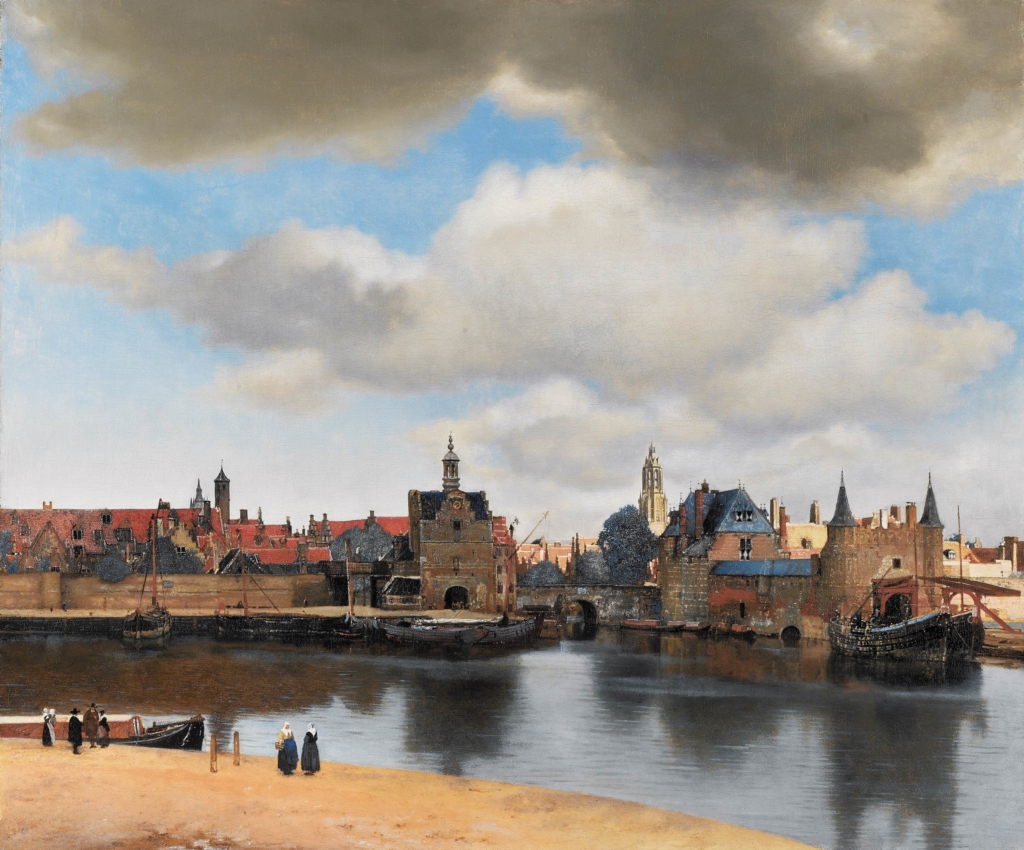 Not a lot of people know this, but Vermeer is the most violent painter who ever lived. As the picture of the dogs playing poker is for Homer Simpson — for myself at least, just to look upon one of his paintings, is to go mad. You can talk about “photo-realism” and the camera obscura as much as you like, but his paintings, at least his mature work, constitute deranged attempts to fix reality as something absolutely still, as a representation of life from which no life could emerge. The whole of the human life-world painted as perfectly — and exactly the same: stiff, dead — as that other archetypal Dutch concern, a basket of flowers next to some lobsters (in French, of course, they call still life paintings, nature morte, nature painted as if it was dead — Vermeer’s innovation is really just to extend that practice to human nature).
Not a lot of people know this, but Vermeer is the most violent painter who ever lived. As the picture of the dogs playing poker is for Homer Simpson — for myself at least, just to look upon one of his paintings, is to go mad. You can talk about “photo-realism” and the camera obscura as much as you like, but his paintings, at least his mature work, constitute deranged attempts to fix reality as something absolutely still, as a representation of life from which no life could emerge. The whole of the human life-world painted as perfectly — and exactly the same: stiff, dead — as that other archetypal Dutch concern, a basket of flowers next to some lobsters (in French, of course, they call still life paintings, nature morte, nature painted as if it was dead — Vermeer’s innovation is really just to extend that practice to human nature).
I saw Vermeer’s View of Delft the other week, in the Mauritshuis in The Hague. It was like staring at a vacuum, or more precisely, like being inside of a vacuum, like I was suddenly struggling for breath, only to find that there was no air outside me at all. The painting depicts a pretty townscape, viewed from across a river. At first it seems photo-realistic, but the effect close-up is more like that of a photo that has been blown up to twice its size and pixellated. There is a distinct blurriness to it, although certainly this is not a blurriness that obscures, as the whole scene impresses itself upon the viewer with great clarity. The houses form a thin line between the river and the clouds. On the near side, six little human figures cluster, in two groups — one of two, one of four. But in truth, there are no signs of life there. Everything is perfectly still: even the ripples in the water on the river look like they have been frozen forever.
The effect of the View of Delft is the precise opposite of that which one gets from the paintings of LS Lowry — all these little figures who give an overwhelming impression of bustling about, in their twee, cartoonish way. However insignificant they are, these little figures seem to be living tiny little lives of their own. This is, in large part, Lowry’s saccharine appeal, giving us an image of a fading industrial British form of urban life as if it were paradise. Vermeer’s matchstick men and women, by contrast, present as the sort of creatures who require, Geulincx-style (and actually Geulincx, also from the Netherlands, was an almost exact contemporary of Vermeer), an all-powerful, omnipotent God to animate them, but that this God figure has (as someone once observed, Beckett’s plays in a different way dramatize) abandoned the world, who knows for how long, so that everything remains static until his return. Perhaps it is no coincidence that in his one known self-portrait (a figure raising a glass on the left-hand side of The Procuress), Vermeer has plastered on his visage the fixed grin of a mocking skull.
Vermeer’s View of Delft is, in short, an utterly delirious image. I couldn’t tear myself away from it, even to the Girl With a Pearl Earring, which everyone else was clustered around on the opposite side of the room. As I stared at it more and more, trying with my eyes somehow to step, like Jonathan Richman, right through the painting, I began to feel dizzy, and had to catch the vomit in my throat, to avoid the embarrassment of evacuating it all over the floor of the Maurithuis.
* * *
In “Refuge for Homeless,” perhaps the most important aphorism from Theodor Adorno’s Minima Moralia (in terms of how the claims he is making there play out in the work more generally), Adorno talks about the impossibility of being at home in one’s own home anymore. This fact, in part, results from architecture. Neither “traditional residences” nor the “functional modern habitations” that are gradually replacing them are held by Adorno to be suitable arenas for what he calls “wohnen (“dwelling”) in its true sense.” The significance of this wohnen (a much more everyday word in German than its English equivalent; used in a sentence “Wo wohnen Sie?” would be most readily translated as “Where do you live?”) is that it indicates something essential for a life we would call fully human — which involves things like freedom, autonomy, and a creative engagement with the world — as opposed to a merely animal existence, which requires only physical survival. For Adorno, nowhere seems to exist anymore where such a fully human life could be lived.

Tom Whyman is a writer and academic philosopher from the UK. He writes a monthly column for Full Stop about architecture.
But the reason for this is not so much how the buildings are in-themselves (that is, in terms of how they are constructed, purely as architectural objects) as what they mean in a more general sense. Older houses, dating from the bourgeois era, are compromised by the horrors and mistakes of that epoch: everything comfortable (or comforting) about the bourgeois form of life is paid for by the guilt that one becomes, as a bourgeois, complicit in; meanwhile the newer sort of dwelling is a direct manifestation of a still more brutal, more perfectly rationalized form of capitalism, which treats even middle-class people like objects: potential sources, if correctly managed, for profit (it is no coincidence — although Adorno only hints at this obliquely — that the Nazi’s concentration camps were typically designed by Bauhaus graduates). Adorno was of course writing over half a century ago, but his insights here remain powerful: wherever we choose to live, we become caught up in hostile forces entirely outside of our control. And yet we cannot, for all that, simply choose to live nowhere. “Dwelling” might be a necessary condition for the possibility of human life, but shelter is necessary if we want to merely survive in our animal being.
Under present conditions we are, in a sense, all squatters: the roof over our head brings us the shelter we need only in the full knowledge that just to partake in it, opens us up to an entire system of obligations that we have no power to alter or resist, that lay in wait as if to pounce any minute: the laws of a world that belongs, in the fullest sense, to someone else. Even those who own their houses typically pay a mortgage to some company that, if things go wrong, has every right to repossess it, and even if you’ve paid all of your mortgage off, you can still only exercise your rights over your property in a quite limited way. The house is, anyway, a paradigmatically illiquid asset (once you’ve invested in it, you cannot escape from it, except at the risk of bankrupting yourself). Hence the paranoia of the homeowner — perhaps the main lode-bearing wall of middle England, as seen through the prism of the Mail and the Express — the feeling that the value of your house is always decreasing, that an undesirable group of people could move in over the street at any moment, that the council could make demands that will bankrupt you, that your neighbors could, in light of their sheer feckless irresponsibility, cause a gas explosion to engulf the entire street, or build a swimming pool in their back garden without planning permission.
But whereas for the home owner this typically remains on the level of paranoid fantasy, it is, much more typically, the everyday reality of those who rent. Landlords make their money by exploiting their tenants and, usually, the more brutally they do this the better. But of course, the violence of the landlord is not usually direct: it manifests itself, rather, in absent-mindedness, in failing to maintain their properties, in “forgetting” to do the paperwork necessary before they can hand back your deposit, in not having the money to pay the guy they’re sending round to fix the boiler right now so can you just pay them and they’ll give you the money back later? Until of course you’re a day late paying your rent, and then they’re suddenly on the ball. Any successful landlord is a crook who pretends to be stupid in order to make you second-guess that they are, effectively, robbing you, but who always demonstrates enough low cunning to make you suspect that they could snatch away both your roof and your deposit at any given moment if ever you fail to capitulate to their demands (besides, what are you going to do, call your team of lawyers in?). Surely it is impossible to feel at home, if every day it becomes the backdrop to your mugging.
Probably the only way to exist happily as a tenant in a rented house would be to have enough security and financial means to be able to move out, at any time, into somewhere equivalently comfortable, while simultaneously being in a position to accept that about an additional £1000 of your money will be lost each year to your landlord in the technicalities. But then of course, that means the situation is, as ever, worse the more vulnerable you are — for those who are just getting by, or who don’t really have families, or whose families don’t have any space to put them up, or they live far away. If you’re at any point just one wrong foot away from rooflessness, then you have no choice but to let the landlord win.
It’s a wretched, debilitating game. In the days before antibiotics and vaccination, bad housing killed its tenants by giving them tuberculosis; now it gives you tuberculosis of the bank balance — when your overdraft is in the red, this is when you’re coughing up blood. And, like a chronic wasting disease, bad housing even pursues you after you’ve left it. It’s been four years since I lived in Manchester, but in my last flat there, the letting agency had a problem getting bills from the gas company, so I never paid any at the time. But, despite having long since paid off what I owed in this regard, I still periodically receive letter from debt collectors who have “tracked me down” in relation to this matter, and insist that if I don’t pay fees ranging upwards of £1,500 immediately, they will be issuing me with a court summons. It doesn’t seem to make any difference how forceful my insistences are, whenever the matter resurfaces, it never seems to fully get resolved. One day I am sure, I will open the mail and discover that I’ve already been imprisoned.
* * *
Something to do with all this was why, anyway, I think I had such a profound reaction to Vermeer’s View of Delft in the Maurithuis. I had bad housing on my mind. We had come to The Hague on our last day in Europe, having elected to travel through the Netherlands on our way back to the UK from Berlin, taking the ferry from the Hook of Holland to Harwich, near to where we would be moving back to. I had spent six months in Berlin, but I couldn’t feel at home there. At first this was not really a housing problem: my flat was very nice. By contrast, I couldn’t really leave it without constantly feeling like I was going to be somehow exposed, and told to get out — in particular that I would expose myself as someone who couldn’t really speak German (hence I spent most social interactions just smiling, nodding, and grunting in order to avoid revealing my accent). Without being able to participate in my environment linguistically, I began to feel as if I wasn’t really there. Thus whatever I found in the city that was interesting and good, I was, by the end, completely desperate just to leave, I guess in the same way that one might be desperate for a drink after completing a difficult and complicated bit of work.
But then towards the end, as I prepared for my escape, this feeling of not really being at home in Berlin became a housing issue too: the usual landlord stuff with deposits and so forth (which I don’t really want to go into because it’s still to a certain extent ongoing), compounded in particular by an incident in which we found ourselves, for reasons somewhat beyond my comprehension, obliged to (and with our own money), get a washing machine fixed in German, despite not really speaking the language and having very little knowledge of either how to get something fixed in Germany, or how washing machines work in general (it would I guess have been an educative experience, if it weren’t the sort of stressful and pointless thing tortured souls probably have to undergo constantly in Hell). And there was another incident before that, actually, a few weeks before — not anything as stressful, but still deeply weird. There had been a block in our drain, which was causing water from our shower to drip into the flat below, and when we got a handyman in to fix it, it turned out that the pipes were packed full of soil — not compost, as would have resulted if waste matter from the sink had gotten down there somehow, but plant soil — and it had to be pumped out by a big machine, which must have been at work for a good ten to fifteen minutes before all the soil was gone, although as to how or why it had got there, no one had any idea . . .
Really what I felt like was that everything about the city that I was unable to participate in (either because the city itself was rejecting me or because I was unable, on a personal level, because of my own anxieties or prejudices, to see my way to participating myself in it), was leaking into my home. Right at the very end, it was getting into my body as well. On my last night in Berlin, I couldn’t stop itching, my skin felt like it was on fire. But the more I itched it, or the more I put moisturiser on it or anything, the more it became infected somehow by what was causing it to itch, which was really the city itself, so in the end I just had to wrap myself up, and not touch it, if I was ever going to get to sleep. It was not until our train crossed the border into the Netherlands (a fact announced to us by the replacement of the clipped and formal German train guard with what had to seem, after so long in Germany, an almost comically friendly and relaxed-sounding Dutch one) that I got any relief.
Vermeer’s View of Delft depicts, as I say, the world as it would be, purged of all human life — in the sense of “human life” as something which involves a certain sort of participation in one’s environment. It is a world in a vacuum, a world that must be forcibly evacuated of any sort of movement, dynamism, or change. Naturally, this is why people so frequently mistake what Vermeer is doing for realism: he presents to us a perfectly-realised artistic vision of the scientific image of the world, in which movement and change do not really, in the end, exist, because everything is perfectly determined by scientific laws in advance (the blind God behind all this must of course then take full responsibility for disguising His advocates as chumps who look like dorks). The human being as a free, autonomous, creative agent can only live against the scientistic image of reality: that, I think, is yet another lesson from Adorno (although this time the best presentation of it is in Dialectic of Enlightenment).
But Vermeer’s painting has also been compared to a vision of heaven (“He took a turbulent reality, and made it look like Heaven on earth,” according to an Andrew Graham-Dixon quote plastered on Wikipedia). Is that not, though, the same thing as the kind of fixing of reality that the natural-scientific image of it implies? Scientism is attractive in part because it allows its advocates to pretend that all the messiness and uncertainty of the world could in principle be reduced to something as perfect and pure as a mathematical formula. But what this means in practice is that everything distinctively human is supposed to have nothing to do with this reality. This is precisely what Wittgenstein found when, still in the early period of his thought (although after his first “retirement”), he attempted to build a house for his sister along the lines of the principles he had outlined in the Tractatus. The project, which he worked obsessively on for two years, was realized, in a sense, completely to Wittgenstein’s intentions — it was, in his view, a completely perfect dwelling. But it was precisely for this reason that it disgusted him. “Even though I admired the house very much, I always knew that I neither wanted to, nor could, live in it myself. It seemed indeed to be much more a dwelling for the gods than for a small mortal like me.” It was in large part the building of this house that ultimately inspired Wittgenstein’s turn against logical positivism and towards his (genuinely radical) late thought, in which the central grounding principle is not logic but rather the idea of a human form of life.
Assuming that such a form of life is not yet possible, what sort of architecture would make it so? What would the relationship need to be between that (residential) architecture and law (especially property law)? And how are these things intertwined with metaphysics? This is a set of questions I am interested in, but do not have an answer to.
This post may contain affiliate links.







